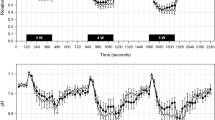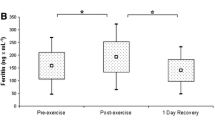Summary
Metabolic responses during a standardized, progressive, maximal work capacity test on a cycle ergometer were studied in 11 women, mean age 28 (SEM 2) years, at admission to the study, after their body iron stores were depleted by diet, phlebotomy and menstruation for about 80 days and after iron repletion by diet for about 100 days, including daily iron supplementation (0.9 mmol iron as ferrous sulfate) for the last 14 days of repletion. Iron depletion was characterized by a decline (P<0.05) in hemoglobin, ferritin and body iron balance. Iron repletion, including supplementation, increased (P<0.05) hemoglobin, ferritin and iron balance. No changes were observed in cardiovascular and ventilatory responses or peak oxygen uptake. Iron depletion was associated with a reduced (P<0.05) rate of oxygen utilization, total oxygen uptake and aerobic energy expenditure, and elevated (P<0.05) peak respiratory exchange ratio and post-exercise concentration of lactate. Reduction of body iron stores without overt anemia affects exercise metabolism by reducing total aerobic energy production and increasing glycolytic metabolism.
Similar content being viewed by others
References
Ackrell BA, Maquire JJ, Dallman PR, Kearney EB (1984) Effect of iron deficiency on succinate and NADH-ubiquinone oxidoreductases in skeletal muscle mitochondria. J Biol Chem 259:10053–10059
Akers R, Buskirk ER (1969) An underwater weighing system utilizing force cube transducers. J Appl Physiol 26:649–652
Analytical Methods Committee (1960) Methods of destruction of organic matter. Analyst 85:643–656
Brooks GA, Henderson SA, Dallman PR (1987) Increased glucose dependence in resting, iron-deficient rats. Am J Physiol 253:E641-E466
Brozek J, Grande F, Anderson JT, Keys A (1963) Densitometric analysis of body composition: revision of some quantitative assumptions. Ann N Y Acad Sci 110:113–140
Celsing F, Blomstrand E, Werner B, Pihlstedt P, Ekblom B (1986) Effects of iron deficiency on endurance and muscle enzyme activity in man. Med Sci Sports Exerc 18:156–161
Cook JD, Finch CA (1979) Assessing iron status of a population. Am J Clin Nutr 32:2115–2119
Dallman PR (1986) Biochemical basis for the manifestations of iron deficiency. Annu Rev Nutr 6:13–40
Davies KJA, Maquire JJ, Brooks GA, Dallman PR, Packer L (1982) Muscle mitochondrial bioenergetics, oxygen supply and work capacity during dietary iron deficiency and repletion. Am J Physiol 242:E418-E427
Davies KJA, Donovan CM, Refino CJ, Brooks GA, Packer L, Dallman PR (1984) Distinguishing effects of anemia and muscle iron deficiency on exercise bioenergetics in the rat. Am J Physiol 246:E535-E543
Dawson-Hughes B, Seligson FH, Hughes VA (1986) Effects of calcium carbonate and hydroxyapatite on zinc and iron retention in postmenopausal women. Am J Clin Nutr 44:83–88
Finch CA, Miller LR, Inamdar AR, Person R, Seiler K, Mackler B (1976) Iron deficiency in the rat: physiological and biochemical studies of muscle dysfunction. J Clin Invest 58:447–453
Finch CA, Gollnick PD, Hlastla P, Miller L, Dillman E, Mackler B (1979) Lactic acidosis as a result of iron deficiency. J Clin Invest 64:129–137
Gregg SG, Kern M, Brooks GA (1989) Acute anemia results in an increased glucose dependence during sustained exercise. J Appl Physiol 66:1874–1880
Hohorst H-J (1963) L-(+)-Lactate: determination with lactate dehydrogenase and DNP. In: Bergmeyer HU (ed) Methods of enzymatic analysis. Academic Press, New York, pp 266–270
Hunt JR, Mullen LK, Lykken GI, Gallagher SK, Nielsen FH (1990) Ascorbic acid: effect on ongoing iron absorption and status in iron depleted young women. Am J Clin Nutr 51:649–655
Keppel G (1973) Design and analysis: a researcher's handbook. Prentice-Hall, Englewood Cliffs, NJ, pp 401–422
Kleinbaum DG, Kupper LL (1978) Applied linear regression analysis and other multivariate methods. Duxbury press, North Scituate, Mass., pp 188–208
Lukaski HC, Bolonchuk WW (1989) Maintenance of aerobic capacity and body composition of volunteers residing on a metabolic research unit. J Sports Med 29:273–278
Lukaski HC, Klevay LM, Milne DB (1988) Effects of dietary copper on human autonomic cardiovascular function. Eur J Appl Physiol 58:74–80
Maquire JJ, Davies KJA, Dallman PR, Packer L (1982) Effect of dietary iron deficiency on iron-sulfur proteins and bio-energetic functions of skeletal muscle mitochondria. Biochim Biophys Acta 756:210–220
McKay RH, Higuchi DA, Winder WW, Fell RD, Brown EB (1983) Tissue effects of iron deficiency in the rat. Biochim Biophys Acta 757:352–358
McLane JA, Fell RD, McKay RH, Winder WW, Brown EB, Holloszy JP (1981) Physiological and biochemical effects of iron deficiency on rat skeletal muscle. Am J Physiol 241:C47-C54
Milne DB, Canfield WK, Mahalko JR, Sandstead HH (1984) Effect of oral folic acid supplements on zinc, copper and iron absorption and excretion. Am J Clin Nutr 39:535–539
Milne DB, Gallagher SK, Nielsen FH (1990) Response of various indices of iron status to acute iron depletion by low iron intake and phlebotomy in menstruating women. Clin Chem 36:487–491
Rowland TW, Deisworth MB, Green GM, Kelleher JF (1988) The effect of iron therapy on the exercise capacity of nonanemic iron-deficient adolescent runners. Am J Dis Child 142:165–169
Scheffé H (1959) The analysis of variance. Wiley, New York, pp 90–137
Schoene RB, Escourrou P, Robertson HT, Nilson KL, Parsons JR, Smith NJ (1983) Iron repletion decreases maximal exercise lactate concentrations in female athletes with minimal irondeficiency anemia. J Lab Clin Med 102:306–312
Snedecor GW, Cochran WG (1973) Statistical methods. Iowa State University Press, Ames, pp 135–171
Viteri FE (1989) Influence of iron nutrition on work capacity and performance. In: Filer LJ (ed) Dietary iron: birth to two years. Raven Press, New York, pp 141–160
Viteri FE, Torun B (1974) Anemia and physical work capacity. Clin Haematol 3:609–626
Weir JB deV (1949) New methods for calculating metabolic rate with special reference to protein metabolism. J Physiol (Lond) 109:1–9
Author information
Authors and Affiliations
Rights and permissions
About this article
Cite this article
Lukaski, H.C., Hall, C.B. & Siders, W.A. Altered metabolic response of iron-deficient women during graded, maximal exercise. Eur J Appl Physiol 63, 140–145 (1991). https://doi.org/10.1007/BF00235184
Accepted:
Issue Date:
DOI: https://doi.org/10.1007/BF00235184




